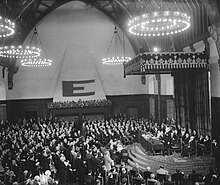Federalist flag
 | |
| Adopted | 1948 |
|---|---|
| Design | Green 'E' letter on a white field |
The federalist flag, also known as the Flag of the European Movement, is a flag commonly used by groups or individuals promoting
History

The flag first appeared at the
The
Design
The flag is dominated by a green, elongated and rigid letter "E" upon a white background. Geometrically, the flag can be divided three ways across and five ways down, all of equal size; the "E" fills the top and bottom fifth, the left most third and one third in the third fifth from the top. The E hence fills two thirds of the area of the elongated flag.
Symbolism
Today, the flag no longer simply stands for European unity, but for the political struggle for a European federation. The flag has been commonly used by citizens, hoisting it at
Indicating, there is a desire among federalists not to let the flag fall into disuse. It is not something that is in competition with the European Union's flag, which the federalists see as representing the status quo. Rather they desire the federalist flag to be used as a
See also
- Flag of Europe (Council of Europe and European Union)
- Flag of the Western Union
- Flag of the Western European Union
- Flag of the European Coal and Steel Community
- European Movement
- Union of European Federalists (UEF)
- History of the European Union
References
- ^ a b c d Soldini, David (28 August 2008) The Federalist Flag, the Battle-Flag for Europe, The New Federalist
- ^ Former Flag of the European Movement, Flags of the World
- ^ Soldini, David (28 August 2008). "The Federalist Flag, the Battle-Flag for Europe". The New Federalist. Retrieved 2 February 2022.
